Australia Post Case Study Analysis: Future Strategies and Reforms
VerifiedAdded on 2023/06/06
|14
|3304
|399
Case Study
AI Summary
This case study analysis examines the key changes and reforms implemented by Australia Post, focusing on its "Future Ready" strategy. It delves into the driving factors behind these changes, including the decline in traditional mail and the rise of digital communication and e-commerce. The report analyzes the people development strategies employed to overcome resistance to change, such as the Post People 1st program and the emphasis on internal recruitment. It also explores how Australia Post has aligned its future strategies to manage change and innovation, including business modernization, community engagement, and environmental commitment. The analysis covers the implementation of a two-speed postal service, the development of digital mailboxes, and the growth of the parcel business. The study highlights the importance of transformational leadership and HRD's role in aligning employee skills with organizational goals. The report concludes with lessons learned from the Australia Post case, emphasizing the need for strategic adaptation and employee development in a dynamic business environment.
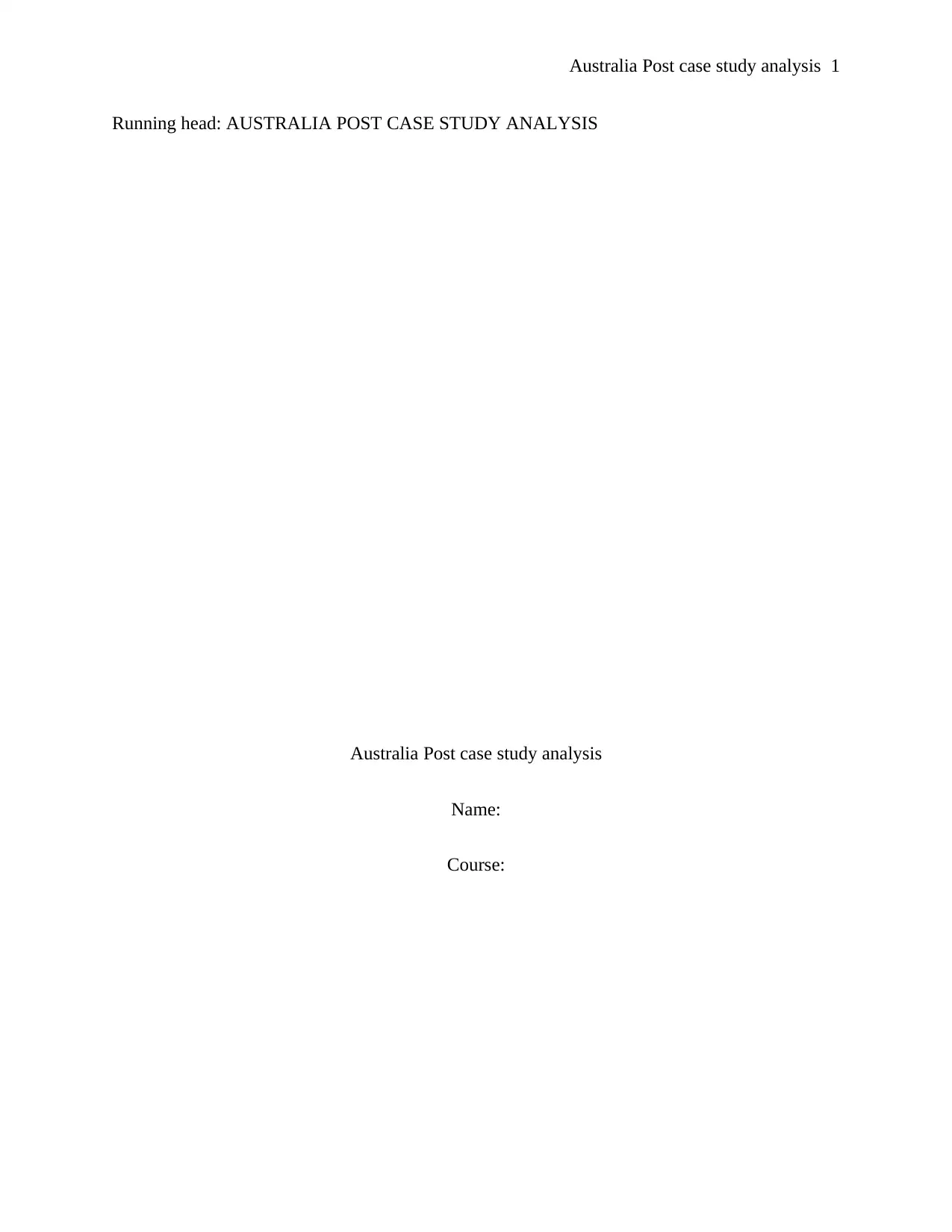
1Australia Post case study analysis
Running head: AUSTRALIA POST CASE STUDY ANALYSIS
Australia Post case study analysis
Name:
Course:
Running head: AUSTRALIA POST CASE STUDY ANALYSIS
Australia Post case study analysis
Name:
Course:
Paraphrase This Document
Need a fresh take? Get an instant paraphrase of this document with our AI Paraphraser
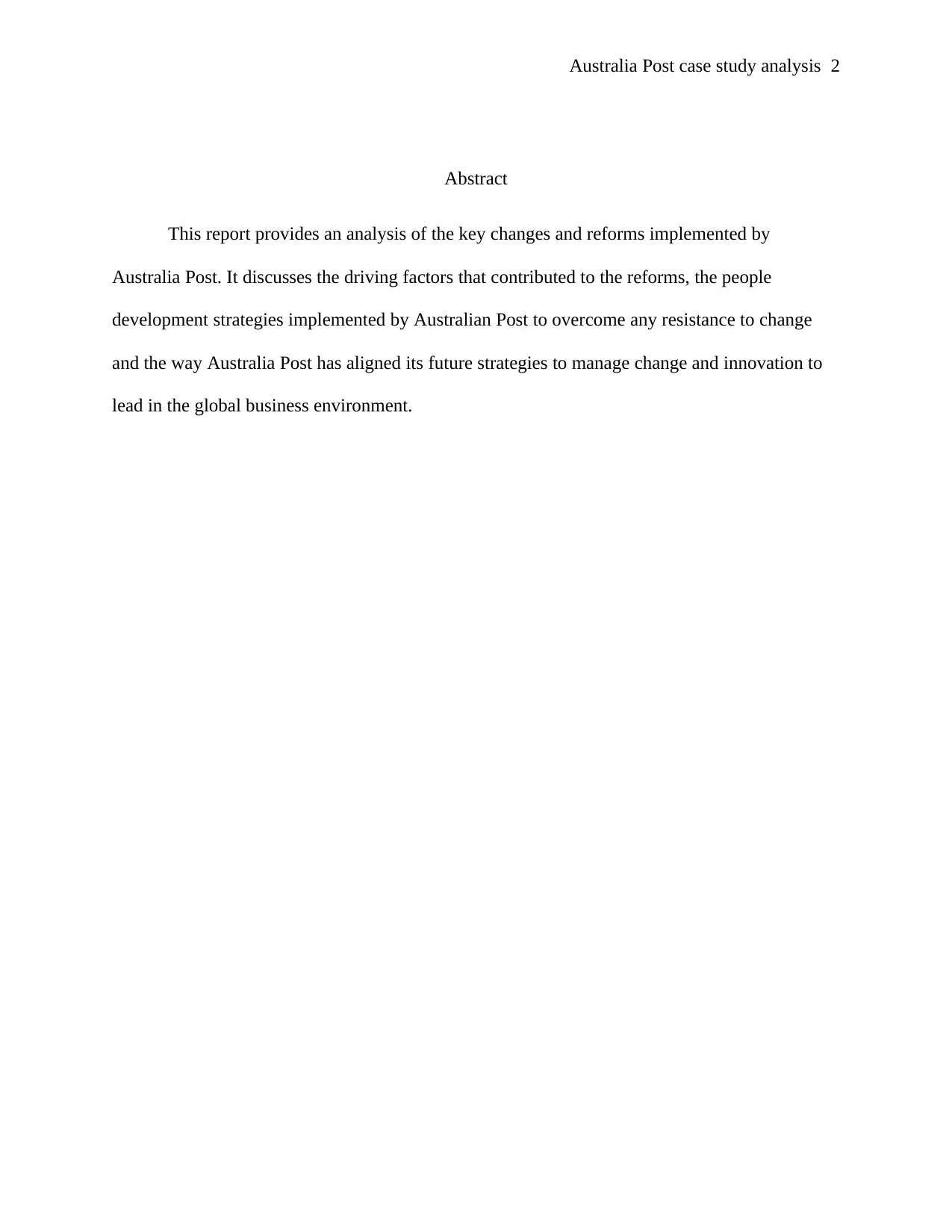
2Australia Post case study analysis
Abstract
This report provides an analysis of the key changes and reforms implemented by
Australia Post. It discusses the driving factors that contributed to the reforms, the people
development strategies implemented by Australian Post to overcome any resistance to change
and the way Australia Post has aligned its future strategies to manage change and innovation to
lead in the global business environment.
Abstract
This report provides an analysis of the key changes and reforms implemented by
Australia Post. It discusses the driving factors that contributed to the reforms, the people
development strategies implemented by Australian Post to overcome any resistance to change
and the way Australia Post has aligned its future strategies to manage change and innovation to
lead in the global business environment.
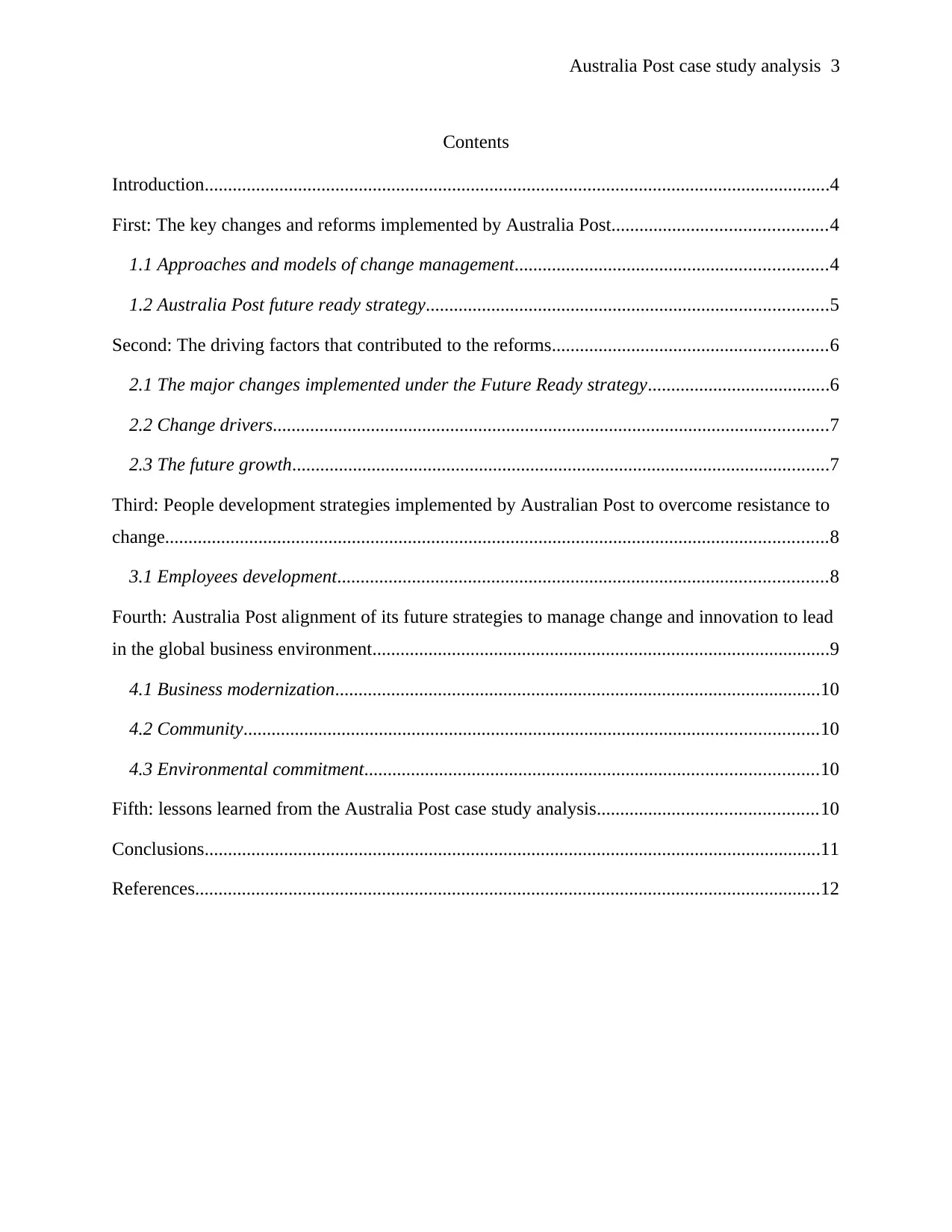
3Australia Post case study analysis
Contents
Introduction......................................................................................................................................4
First: The key changes and reforms implemented by Australia Post..............................................4
1.1 Approaches and models of change management...................................................................4
1.2 Australia Post future ready strategy......................................................................................5
Second: The driving factors that contributed to the reforms...........................................................6
2.1 The major changes implemented under the Future Ready strategy.......................................6
2.2 Change drivers.......................................................................................................................7
2.3 The future growth...................................................................................................................7
Third: People development strategies implemented by Australian Post to overcome resistance to
change..............................................................................................................................................8
3.1 Employees development.........................................................................................................8
Fourth: Australia Post alignment of its future strategies to manage change and innovation to lead
in the global business environment..................................................................................................9
4.1 Business modernization........................................................................................................10
4.2 Community...........................................................................................................................10
4.3 Environmental commitment.................................................................................................10
Fifth: lessons learned from the Australia Post case study analysis...............................................10
Conclusions....................................................................................................................................11
References......................................................................................................................................12
Contents
Introduction......................................................................................................................................4
First: The key changes and reforms implemented by Australia Post..............................................4
1.1 Approaches and models of change management...................................................................4
1.2 Australia Post future ready strategy......................................................................................5
Second: The driving factors that contributed to the reforms...........................................................6
2.1 The major changes implemented under the Future Ready strategy.......................................6
2.2 Change drivers.......................................................................................................................7
2.3 The future growth...................................................................................................................7
Third: People development strategies implemented by Australian Post to overcome resistance to
change..............................................................................................................................................8
3.1 Employees development.........................................................................................................8
Fourth: Australia Post alignment of its future strategies to manage change and innovation to lead
in the global business environment..................................................................................................9
4.1 Business modernization........................................................................................................10
4.2 Community...........................................................................................................................10
4.3 Environmental commitment.................................................................................................10
Fifth: lessons learned from the Australia Post case study analysis...............................................10
Conclusions....................................................................................................................................11
References......................................................................................................................................12
⊘ This is a preview!⊘
Do you want full access?
Subscribe today to unlock all pages.

Trusted by 1+ million students worldwide
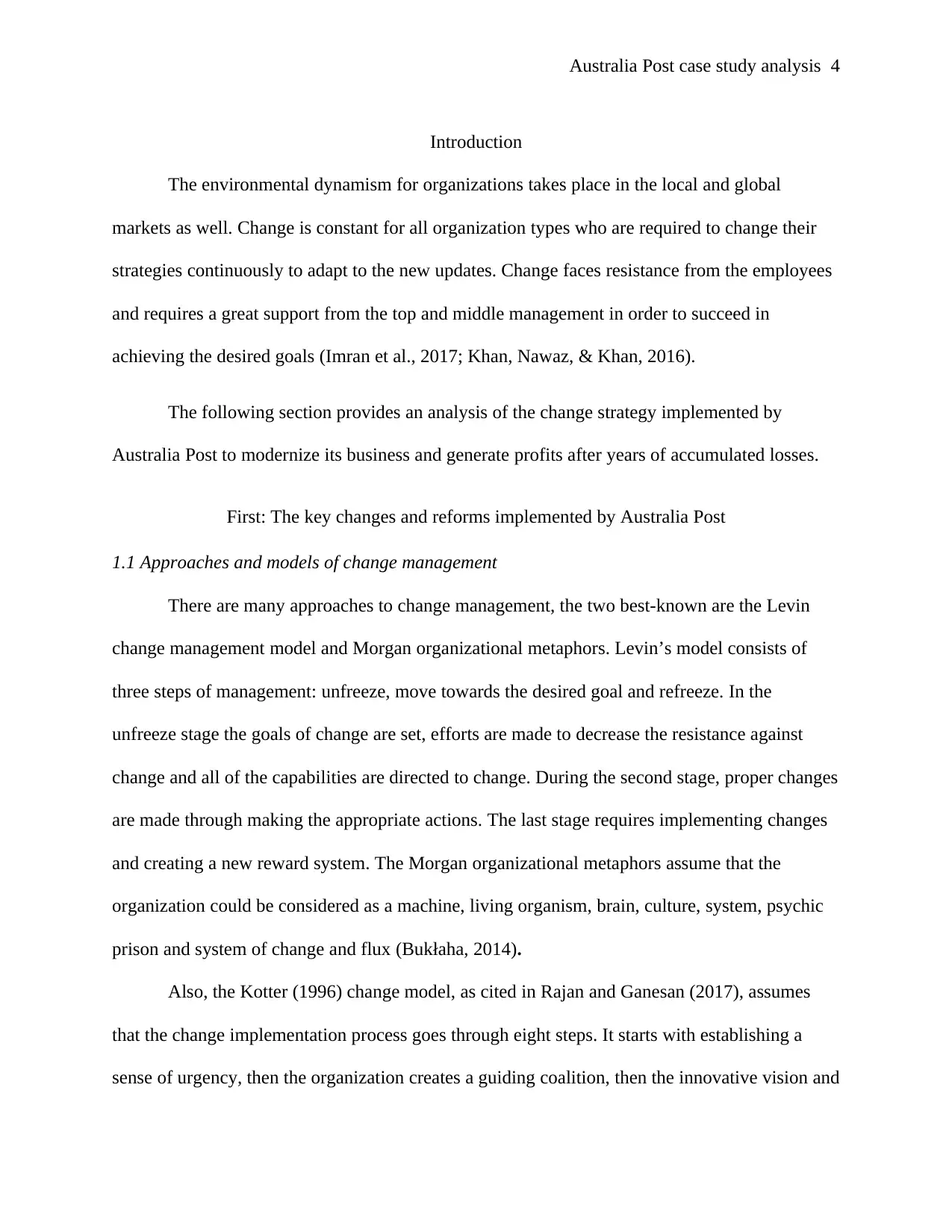
4Australia Post case study analysis
Introduction
The environmental dynamism for organizations takes place in the local and global
markets as well. Change is constant for all organization types who are required to change their
strategies continuously to adapt to the new updates. Change faces resistance from the employees
and requires a great support from the top and middle management in order to succeed in
achieving the desired goals (Imran et al., 2017; Khan, Nawaz, & Khan, 2016).
The following section provides an analysis of the change strategy implemented by
Australia Post to modernize its business and generate profits after years of accumulated losses.
First: The key changes and reforms implemented by Australia Post
1.1 Approaches and models of change management
There are many approaches to change management, the two best-known are the Levin
change management model and Morgan organizational metaphors. Levin’s model consists of
three steps of management: unfreeze, move towards the desired goal and refreeze. In the
unfreeze stage the goals of change are set, efforts are made to decrease the resistance against
change and all of the capabilities are directed to change. During the second stage, proper changes
are made through making the appropriate actions. The last stage requires implementing changes
and creating a new reward system. The Morgan organizational metaphors assume that the
organization could be considered as a machine, living organism, brain, culture, system, psychic
prison and system of change and flux (Bukłaha, 2014).
Also, the Kotter (1996) change model, as cited in Rajan and Ganesan (2017), assumes
that the change implementation process goes through eight steps. It starts with establishing a
sense of urgency, then the organization creates a guiding coalition, then the innovative vision and
Introduction
The environmental dynamism for organizations takes place in the local and global
markets as well. Change is constant for all organization types who are required to change their
strategies continuously to adapt to the new updates. Change faces resistance from the employees
and requires a great support from the top and middle management in order to succeed in
achieving the desired goals (Imran et al., 2017; Khan, Nawaz, & Khan, 2016).
The following section provides an analysis of the change strategy implemented by
Australia Post to modernize its business and generate profits after years of accumulated losses.
First: The key changes and reforms implemented by Australia Post
1.1 Approaches and models of change management
There are many approaches to change management, the two best-known are the Levin
change management model and Morgan organizational metaphors. Levin’s model consists of
three steps of management: unfreeze, move towards the desired goal and refreeze. In the
unfreeze stage the goals of change are set, efforts are made to decrease the resistance against
change and all of the capabilities are directed to change. During the second stage, proper changes
are made through making the appropriate actions. The last stage requires implementing changes
and creating a new reward system. The Morgan organizational metaphors assume that the
organization could be considered as a machine, living organism, brain, culture, system, psychic
prison and system of change and flux (Bukłaha, 2014).
Also, the Kotter (1996) change model, as cited in Rajan and Ganesan (2017), assumes
that the change implementation process goes through eight steps. It starts with establishing a
sense of urgency, then the organization creates a guiding coalition, then the innovative vision and
Paraphrase This Document
Need a fresh take? Get an instant paraphrase of this document with our AI Paraphraser
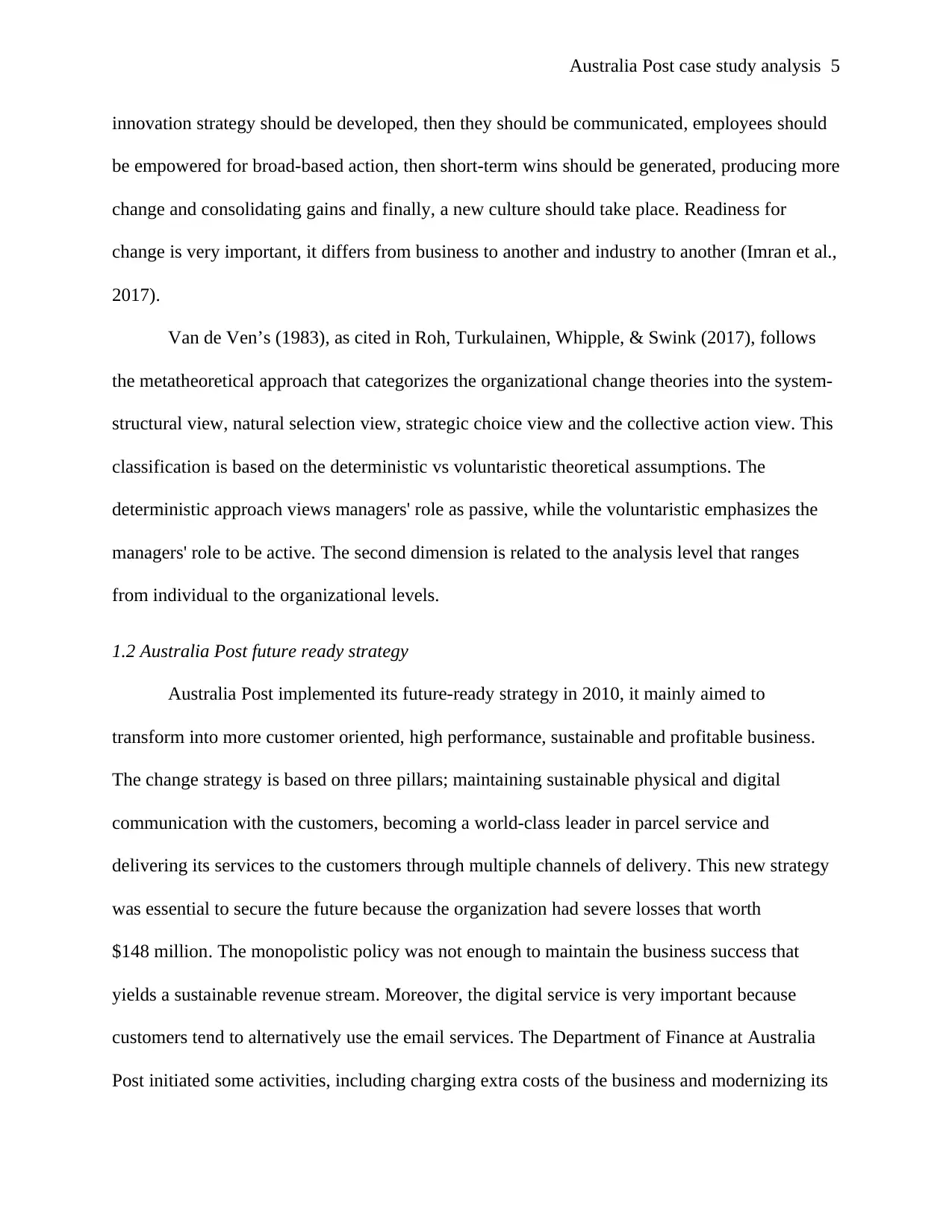
5Australia Post case study analysis
innovation strategy should be developed, then they should be communicated, employees should
be empowered for broad-based action, then short-term wins should be generated, producing more
change and consolidating gains and finally, a new culture should take place. Readiness for
change is very important, it differs from business to another and industry to another (Imran et al.,
2017).
Van de Ven’s (1983), as cited in Roh, Turkulainen, Whipple, & Swink (2017), follows
the metatheoretical approach that categorizes the organizational change theories into the system-
structural view, natural selection view, strategic choice view and the collective action view. This
classification is based on the deterministic vs voluntaristic theoretical assumptions. The
deterministic approach views managers' role as passive, while the voluntaristic emphasizes the
managers' role to be active. The second dimension is related to the analysis level that ranges
from individual to the organizational levels.
1.2 Australia Post future ready strategy
Australia Post implemented its future-ready strategy in 2010, it mainly aimed to
transform into more customer oriented, high performance, sustainable and profitable business.
The change strategy is based on three pillars; maintaining sustainable physical and digital
communication with the customers, becoming a world-class leader in parcel service and
delivering its services to the customers through multiple channels of delivery. This new strategy
was essential to secure the future because the organization had severe losses that worth
$148 million. The monopolistic policy was not enough to maintain the business success that
yields a sustainable revenue stream. Moreover, the digital service is very important because
customers tend to alternatively use the email services. The Department of Finance at Australia
Post initiated some activities, including charging extra costs of the business and modernizing its
innovation strategy should be developed, then they should be communicated, employees should
be empowered for broad-based action, then short-term wins should be generated, producing more
change and consolidating gains and finally, a new culture should take place. Readiness for
change is very important, it differs from business to another and industry to another (Imran et al.,
2017).
Van de Ven’s (1983), as cited in Roh, Turkulainen, Whipple, & Swink (2017), follows
the metatheoretical approach that categorizes the organizational change theories into the system-
structural view, natural selection view, strategic choice view and the collective action view. This
classification is based on the deterministic vs voluntaristic theoretical assumptions. The
deterministic approach views managers' role as passive, while the voluntaristic emphasizes the
managers' role to be active. The second dimension is related to the analysis level that ranges
from individual to the organizational levels.
1.2 Australia Post future ready strategy
Australia Post implemented its future-ready strategy in 2010, it mainly aimed to
transform into more customer oriented, high performance, sustainable and profitable business.
The change strategy is based on three pillars; maintaining sustainable physical and digital
communication with the customers, becoming a world-class leader in parcel service and
delivering its services to the customers through multiple channels of delivery. This new strategy
was essential to secure the future because the organization had severe losses that worth
$148 million. The monopolistic policy was not enough to maintain the business success that
yields a sustainable revenue stream. Moreover, the digital service is very important because
customers tend to alternatively use the email services. The Department of Finance at Australia
Post initiated some activities, including charging extra costs of the business and modernizing its
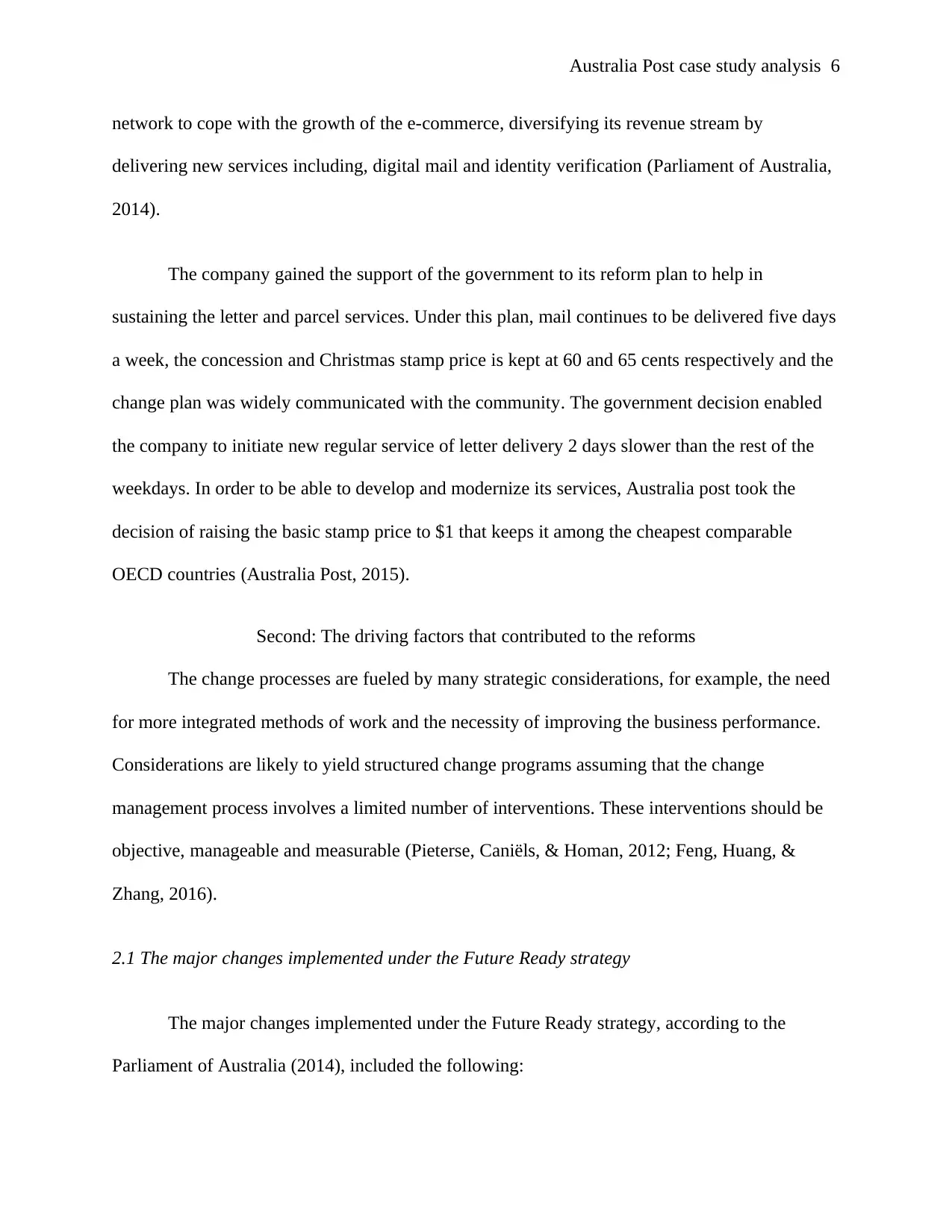
6Australia Post case study analysis
network to cope with the growth of the e-commerce, diversifying its revenue stream by
delivering new services including, digital mail and identity verification (Parliament of Australia,
2014).
The company gained the support of the government to its reform plan to help in
sustaining the letter and parcel services. Under this plan, mail continues to be delivered five days
a week, the concession and Christmas stamp price is kept at 60 and 65 cents respectively and the
change plan was widely communicated with the community. The government decision enabled
the company to initiate new regular service of letter delivery 2 days slower than the rest of the
weekdays. In order to be able to develop and modernize its services, Australia post took the
decision of raising the basic stamp price to $1 that keeps it among the cheapest comparable
OECD countries (Australia Post, 2015).
Second: The driving factors that contributed to the reforms
The change processes are fueled by many strategic considerations, for example, the need
for more integrated methods of work and the necessity of improving the business performance.
Considerations are likely to yield structured change programs assuming that the change
management process involves a limited number of interventions. These interventions should be
objective, manageable and measurable (Pieterse, Caniëls, & Homan, 2012; Feng, Huang, &
Zhang, 2016).
2.1 The major changes implemented under the Future Ready strategy
The major changes implemented under the Future Ready strategy, according to the
Parliament of Australia (2014), included the following:
network to cope with the growth of the e-commerce, diversifying its revenue stream by
delivering new services including, digital mail and identity verification (Parliament of Australia,
2014).
The company gained the support of the government to its reform plan to help in
sustaining the letter and parcel services. Under this plan, mail continues to be delivered five days
a week, the concession and Christmas stamp price is kept at 60 and 65 cents respectively and the
change plan was widely communicated with the community. The government decision enabled
the company to initiate new regular service of letter delivery 2 days slower than the rest of the
weekdays. In order to be able to develop and modernize its services, Australia post took the
decision of raising the basic stamp price to $1 that keeps it among the cheapest comparable
OECD countries (Australia Post, 2015).
Second: The driving factors that contributed to the reforms
The change processes are fueled by many strategic considerations, for example, the need
for more integrated methods of work and the necessity of improving the business performance.
Considerations are likely to yield structured change programs assuming that the change
management process involves a limited number of interventions. These interventions should be
objective, manageable and measurable (Pieterse, Caniëls, & Homan, 2012; Feng, Huang, &
Zhang, 2016).
2.1 The major changes implemented under the Future Ready strategy
The major changes implemented under the Future Ready strategy, according to the
Parliament of Australia (2014), included the following:
⊘ This is a preview!⊘
Do you want full access?
Subscribe today to unlock all pages.

Trusted by 1+ million students worldwide
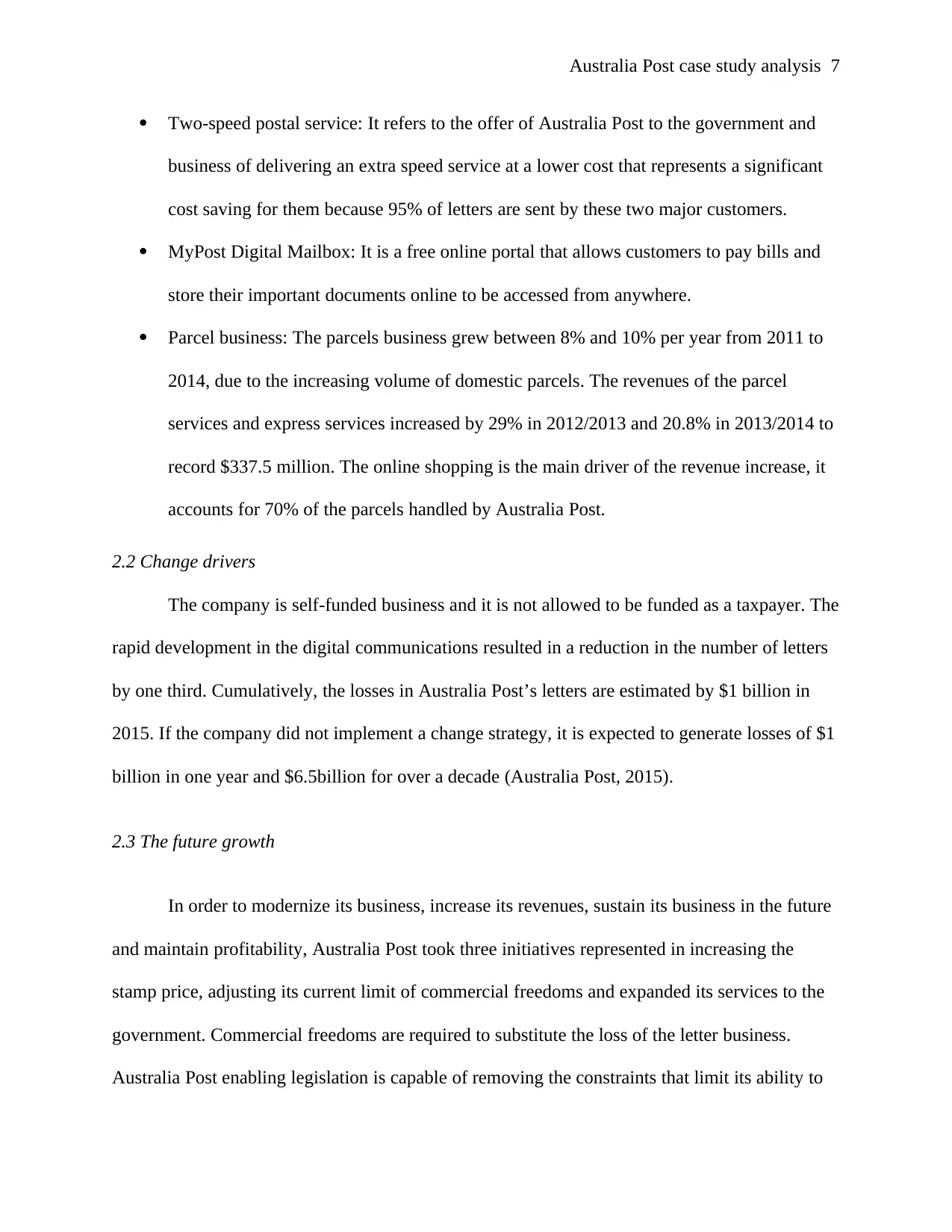
7Australia Post case study analysis
Two-speed postal service: It refers to the offer of Australia Post to the government and
business of delivering an extra speed service at a lower cost that represents a significant
cost saving for them because 95% of letters are sent by these two major customers.
MyPost Digital Mailbox: It is a free online portal that allows customers to pay bills and
store their important documents online to be accessed from anywhere.
Parcel business: The parcels business grew between 8% and 10% per year from 2011 to
2014, due to the increasing volume of domestic parcels. The revenues of the parcel
services and express services increased by 29% in 2012/2013 and 20.8% in 2013/2014 to
record $337.5 million. The online shopping is the main driver of the revenue increase, it
accounts for 70% of the parcels handled by Australia Post.
2.2 Change drivers
The company is self-funded business and it is not allowed to be funded as a taxpayer. The
rapid development in the digital communications resulted in a reduction in the number of letters
by one third. Cumulatively, the losses in Australia Post’s letters are estimated by $1 billion in
2015. If the company did not implement a change strategy, it is expected to generate losses of $1
billion in one year and $6.5billion for over a decade (Australia Post, 2015).
2.3 The future growth
In order to modernize its business, increase its revenues, sustain its business in the future
and maintain profitability, Australia Post took three initiatives represented in increasing the
stamp price, adjusting its current limit of commercial freedoms and expanded its services to the
government. Commercial freedoms are required to substitute the loss of the letter business.
Australia Post enabling legislation is capable of removing the constraints that limit its ability to
Two-speed postal service: It refers to the offer of Australia Post to the government and
business of delivering an extra speed service at a lower cost that represents a significant
cost saving for them because 95% of letters are sent by these two major customers.
MyPost Digital Mailbox: It is a free online portal that allows customers to pay bills and
store their important documents online to be accessed from anywhere.
Parcel business: The parcels business grew between 8% and 10% per year from 2011 to
2014, due to the increasing volume of domestic parcels. The revenues of the parcel
services and express services increased by 29% in 2012/2013 and 20.8% in 2013/2014 to
record $337.5 million. The online shopping is the main driver of the revenue increase, it
accounts for 70% of the parcels handled by Australia Post.
2.2 Change drivers
The company is self-funded business and it is not allowed to be funded as a taxpayer. The
rapid development in the digital communications resulted in a reduction in the number of letters
by one third. Cumulatively, the losses in Australia Post’s letters are estimated by $1 billion in
2015. If the company did not implement a change strategy, it is expected to generate losses of $1
billion in one year and $6.5billion for over a decade (Australia Post, 2015).
2.3 The future growth
In order to modernize its business, increase its revenues, sustain its business in the future
and maintain profitability, Australia Post took three initiatives represented in increasing the
stamp price, adjusting its current limit of commercial freedoms and expanded its services to the
government. Commercial freedoms are required to substitute the loss of the letter business.
Australia Post enabling legislation is capable of removing the constraints that limit its ability to
Paraphrase This Document
Need a fresh take? Get an instant paraphrase of this document with our AI Paraphraser
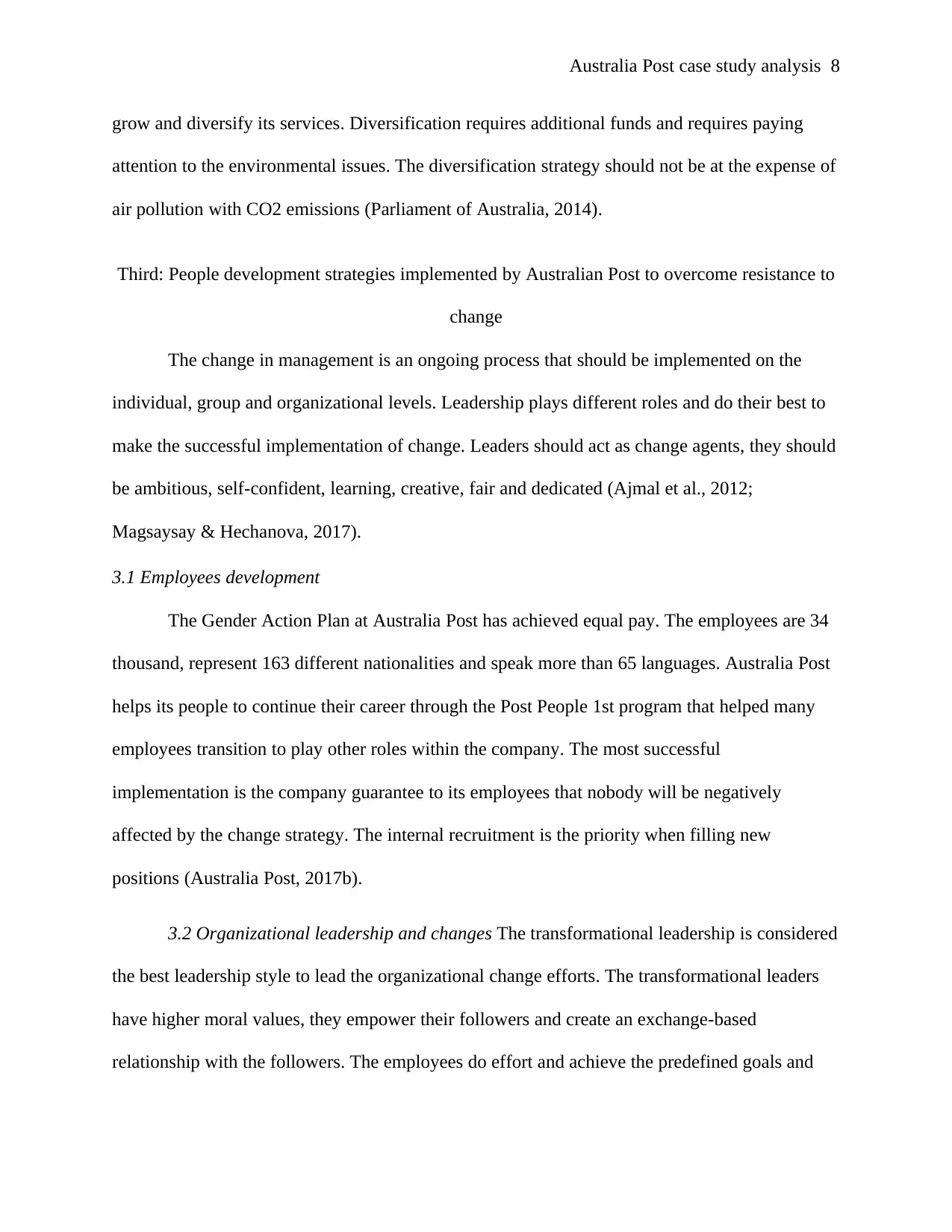
8Australia Post case study analysis
grow and diversify its services. Diversification requires additional funds and requires paying
attention to the environmental issues. The diversification strategy should not be at the expense of
air pollution with CO2 emissions (Parliament of Australia, 2014).
Third: People development strategies implemented by Australian Post to overcome resistance to
change
The change in management is an ongoing process that should be implemented on the
individual, group and organizational levels. Leadership plays different roles and do their best to
make the successful implementation of change. Leaders should act as change agents, they should
be ambitious, self-confident, learning, creative, fair and dedicated (Ajmal et al., 2012;
Magsaysay & Hechanova, 2017).
3.1 Employees development
The Gender Action Plan at Australia Post has achieved equal pay. The employees are 34
thousand, represent 163 different nationalities and speak more than 65 languages. Australia Post
helps its people to continue their career through the Post People 1st program that helped many
employees transition to play other roles within the company. The most successful
implementation is the company guarantee to its employees that nobody will be negatively
affected by the change strategy. The internal recruitment is the priority when filling new
positions (Australia Post, 2017b).
3.2 Organizational leadership and changes The transformational leadership is considered
the best leadership style to lead the organizational change efforts. The transformational leaders
have higher moral values, they empower their followers and create an exchange-based
relationship with the followers. The employees do effort and achieve the predefined goals and
grow and diversify its services. Diversification requires additional funds and requires paying
attention to the environmental issues. The diversification strategy should not be at the expense of
air pollution with CO2 emissions (Parliament of Australia, 2014).
Third: People development strategies implemented by Australian Post to overcome resistance to
change
The change in management is an ongoing process that should be implemented on the
individual, group and organizational levels. Leadership plays different roles and do their best to
make the successful implementation of change. Leaders should act as change agents, they should
be ambitious, self-confident, learning, creative, fair and dedicated (Ajmal et al., 2012;
Magsaysay & Hechanova, 2017).
3.1 Employees development
The Gender Action Plan at Australia Post has achieved equal pay. The employees are 34
thousand, represent 163 different nationalities and speak more than 65 languages. Australia Post
helps its people to continue their career through the Post People 1st program that helped many
employees transition to play other roles within the company. The most successful
implementation is the company guarantee to its employees that nobody will be negatively
affected by the change strategy. The internal recruitment is the priority when filling new
positions (Australia Post, 2017b).
3.2 Organizational leadership and changes The transformational leadership is considered
the best leadership style to lead the organizational change efforts. The transformational leaders
have higher moral values, they empower their followers and create an exchange-based
relationship with the followers. The employees do effort and achieve the predefined goals and
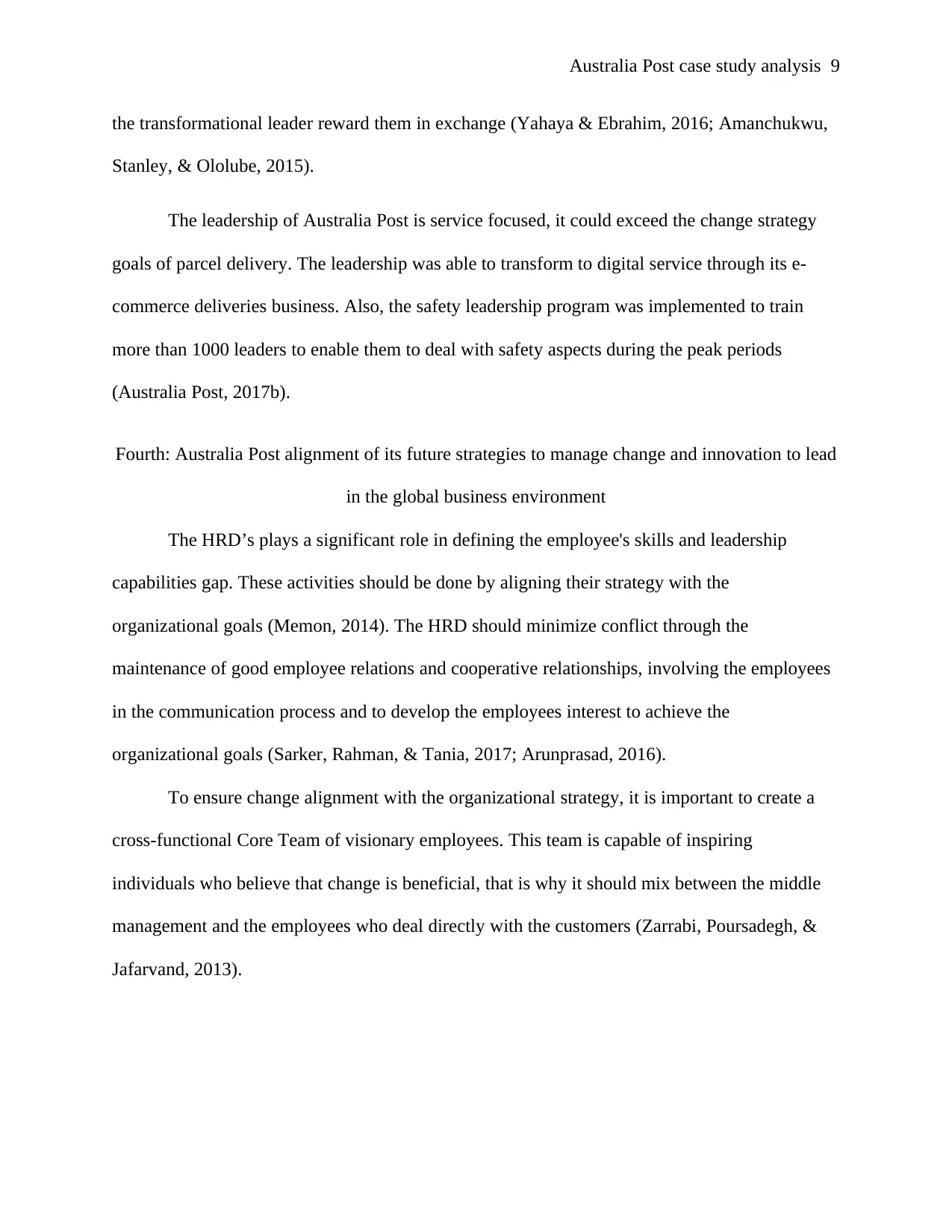
9Australia Post case study analysis
the transformational leader reward them in exchange (Yahaya & Ebrahim, 2016; Amanchukwu,
Stanley, & Ololube, 2015).
The leadership of Australia Post is service focused, it could exceed the change strategy
goals of parcel delivery. The leadership was able to transform to digital service through its e-
commerce deliveries business. Also, the safety leadership program was implemented to train
more than 1000 leaders to enable them to deal with safety aspects during the peak periods
(Australia Post, 2017b).
Fourth: Australia Post alignment of its future strategies to manage change and innovation to lead
in the global business environment
The HRD’s plays a significant role in defining the employee's skills and leadership
capabilities gap. These activities should be done by aligning their strategy with the
organizational goals (Memon, 2014). The HRD should minimize conflict through the
maintenance of good employee relations and cooperative relationships, involving the employees
in the communication process and to develop the employees interest to achieve the
organizational goals (Sarker, Rahman, & Tania, 2017; Arunprasad, 2016).
To ensure change alignment with the organizational strategy, it is important to create a
cross-functional Core Team of visionary employees. This team is capable of inspiring
individuals who believe that change is beneficial, that is why it should mix between the middle
management and the employees who deal directly with the customers (Zarrabi, Poursadegh, &
Jafarvand, 2013).
the transformational leader reward them in exchange (Yahaya & Ebrahim, 2016; Amanchukwu,
Stanley, & Ololube, 2015).
The leadership of Australia Post is service focused, it could exceed the change strategy
goals of parcel delivery. The leadership was able to transform to digital service through its e-
commerce deliveries business. Also, the safety leadership program was implemented to train
more than 1000 leaders to enable them to deal with safety aspects during the peak periods
(Australia Post, 2017b).
Fourth: Australia Post alignment of its future strategies to manage change and innovation to lead
in the global business environment
The HRD’s plays a significant role in defining the employee's skills and leadership
capabilities gap. These activities should be done by aligning their strategy with the
organizational goals (Memon, 2014). The HRD should minimize conflict through the
maintenance of good employee relations and cooperative relationships, involving the employees
in the communication process and to develop the employees interest to achieve the
organizational goals (Sarker, Rahman, & Tania, 2017; Arunprasad, 2016).
To ensure change alignment with the organizational strategy, it is important to create a
cross-functional Core Team of visionary employees. This team is capable of inspiring
individuals who believe that change is beneficial, that is why it should mix between the middle
management and the employees who deal directly with the customers (Zarrabi, Poursadegh, &
Jafarvand, 2013).
⊘ This is a preview!⊘
Do you want full access?
Subscribe today to unlock all pages.

Trusted by 1+ million students worldwide
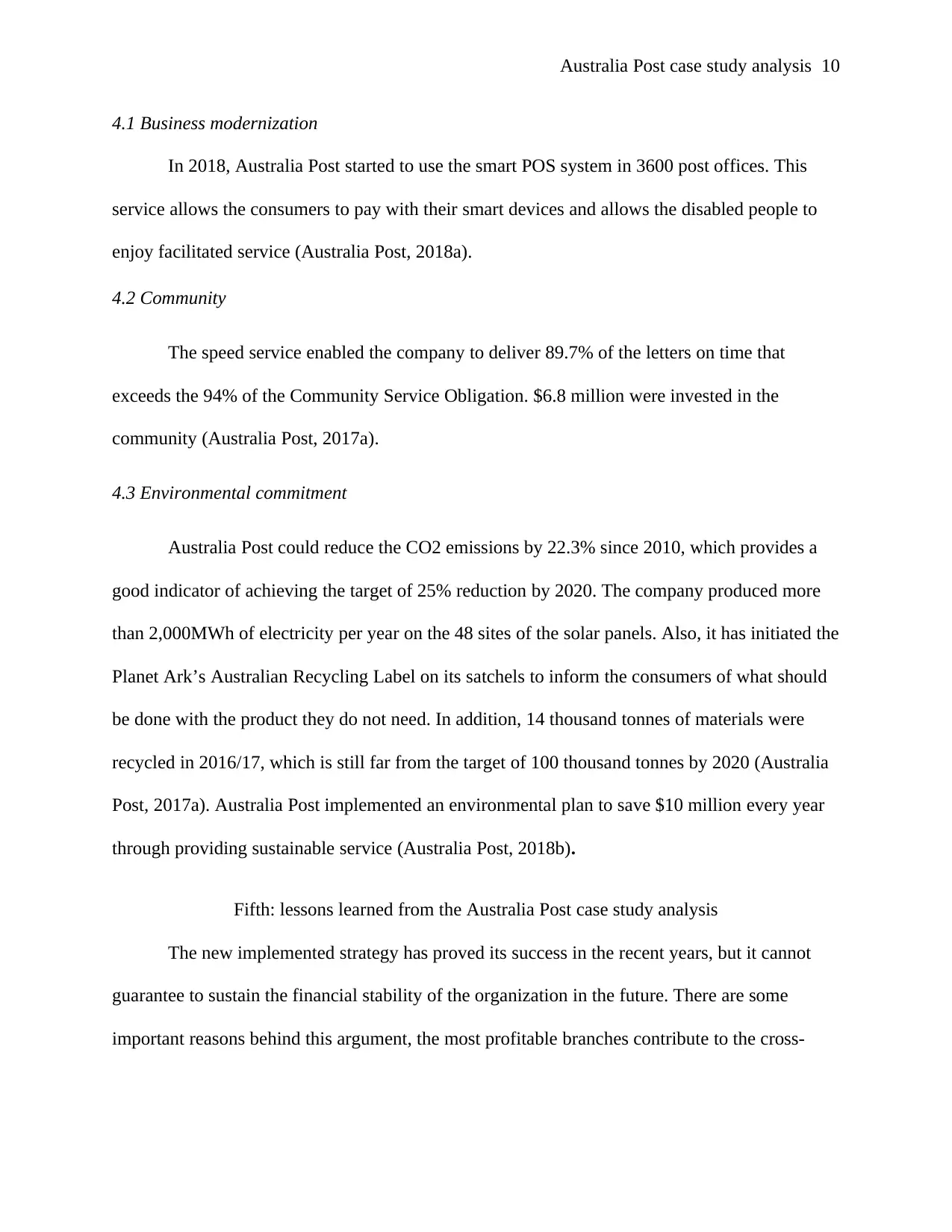
10Australia Post case study analysis
4.1 Business modernization
In 2018, Australia Post started to use the smart POS system in 3600 post offices. This
service allows the consumers to pay with their smart devices and allows the disabled people to
enjoy facilitated service (Australia Post, 2018a).
4.2 Community
The speed service enabled the company to deliver 89.7% of the letters on time that
exceeds the 94% of the Community Service Obligation. $6.8 million were invested in the
community (Australia Post, 2017a).
4.3 Environmental commitment
Australia Post could reduce the CO2 emissions by 22.3% since 2010, which provides a
good indicator of achieving the target of 25% reduction by 2020. The company produced more
than 2,000MWh of electricity per year on the 48 sites of the solar panels. Also, it has initiated the
Planet Ark’s Australian Recycling Label on its satchels to inform the consumers of what should
be done with the product they do not need. In addition, 14 thousand tonnes of materials were
recycled in 2016/17, which is still far from the target of 100 thousand tonnes by 2020 (Australia
Post, 2017a). Australia Post implemented an environmental plan to save $10 million every year
through providing sustainable service (Australia Post, 2018b).
Fifth: lessons learned from the Australia Post case study analysis
The new implemented strategy has proved its success in the recent years, but it cannot
guarantee to sustain the financial stability of the organization in the future. There are some
important reasons behind this argument, the most profitable branches contribute to the cross-
4.1 Business modernization
In 2018, Australia Post started to use the smart POS system in 3600 post offices. This
service allows the consumers to pay with their smart devices and allows the disabled people to
enjoy facilitated service (Australia Post, 2018a).
4.2 Community
The speed service enabled the company to deliver 89.7% of the letters on time that
exceeds the 94% of the Community Service Obligation. $6.8 million were invested in the
community (Australia Post, 2017a).
4.3 Environmental commitment
Australia Post could reduce the CO2 emissions by 22.3% since 2010, which provides a
good indicator of achieving the target of 25% reduction by 2020. The company produced more
than 2,000MWh of electricity per year on the 48 sites of the solar panels. Also, it has initiated the
Planet Ark’s Australian Recycling Label on its satchels to inform the consumers of what should
be done with the product they do not need. In addition, 14 thousand tonnes of materials were
recycled in 2016/17, which is still far from the target of 100 thousand tonnes by 2020 (Australia
Post, 2017a). Australia Post implemented an environmental plan to save $10 million every year
through providing sustainable service (Australia Post, 2018b).
Fifth: lessons learned from the Australia Post case study analysis
The new implemented strategy has proved its success in the recent years, but it cannot
guarantee to sustain the financial stability of the organization in the future. There are some
important reasons behind this argument, the most profitable branches contribute to the cross-
Paraphrase This Document
Need a fresh take? Get an instant paraphrase of this document with our AI Paraphraser
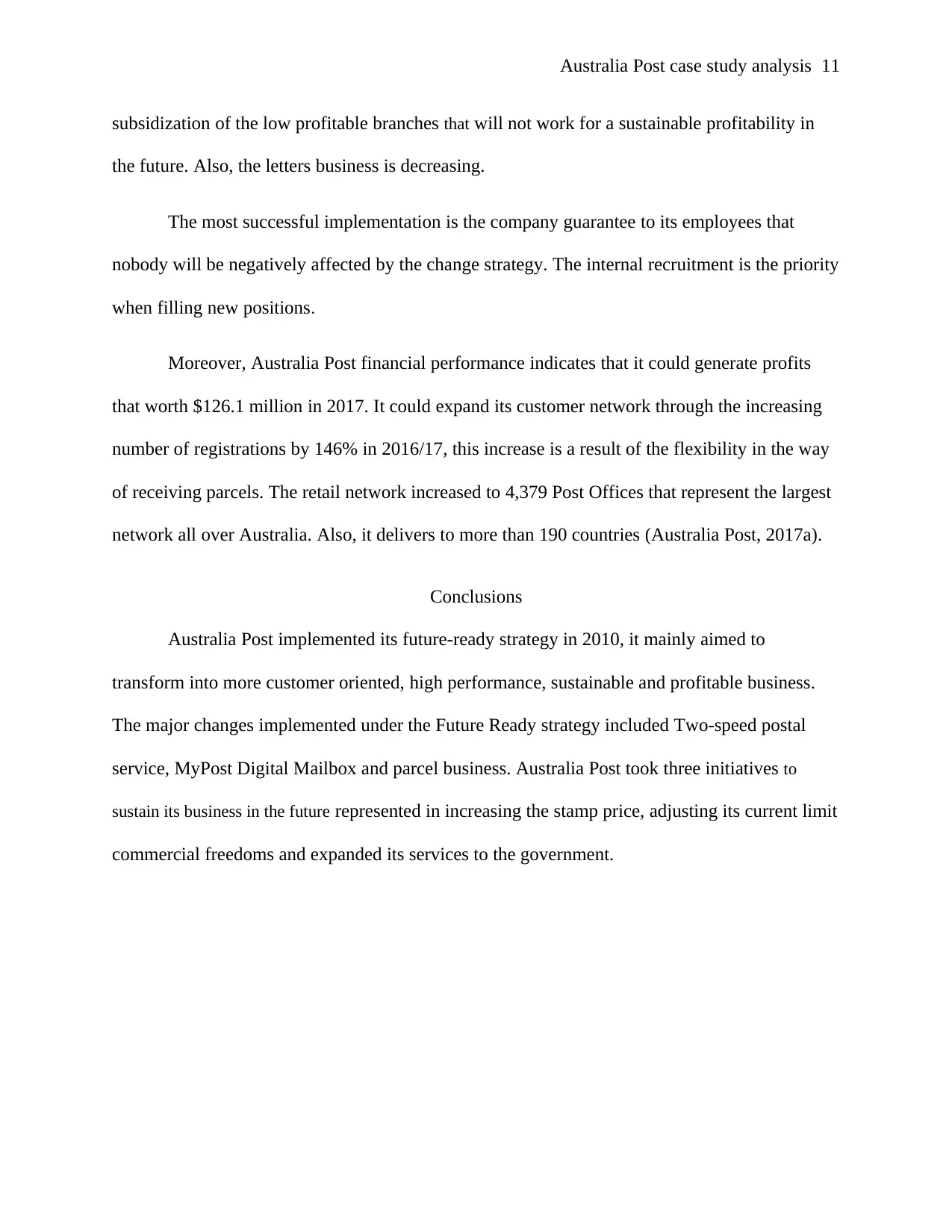
11Australia Post case study analysis
subsidization of the low profitable branches that will not work for a sustainable profitability in
the future. Also, the letters business is decreasing.
The most successful implementation is the company guarantee to its employees that
nobody will be negatively affected by the change strategy. The internal recruitment is the priority
when filling new positions.
Moreover, Australia Post financial performance indicates that it could generate profits
that worth $126.1 million in 2017. It could expand its customer network through the increasing
number of registrations by 146% in 2016/17, this increase is a result of the flexibility in the way
of receiving parcels. The retail network increased to 4,379 Post Offices that represent the largest
network all over Australia. Also, it delivers to more than 190 countries (Australia Post, 2017a).
Conclusions
Australia Post implemented its future-ready strategy in 2010, it mainly aimed to
transform into more customer oriented, high performance, sustainable and profitable business.
The major changes implemented under the Future Ready strategy included Two-speed postal
service, MyPost Digital Mailbox and parcel business. Australia Post took three initiatives to
sustain its business in the future represented in increasing the stamp price, adjusting its current limit
commercial freedoms and expanded its services to the government.
subsidization of the low profitable branches that will not work for a sustainable profitability in
the future. Also, the letters business is decreasing.
The most successful implementation is the company guarantee to its employees that
nobody will be negatively affected by the change strategy. The internal recruitment is the priority
when filling new positions.
Moreover, Australia Post financial performance indicates that it could generate profits
that worth $126.1 million in 2017. It could expand its customer network through the increasing
number of registrations by 146% in 2016/17, this increase is a result of the flexibility in the way
of receiving parcels. The retail network increased to 4,379 Post Offices that represent the largest
network all over Australia. Also, it delivers to more than 190 countries (Australia Post, 2017a).
Conclusions
Australia Post implemented its future-ready strategy in 2010, it mainly aimed to
transform into more customer oriented, high performance, sustainable and profitable business.
The major changes implemented under the Future Ready strategy included Two-speed postal
service, MyPost Digital Mailbox and parcel business. Australia Post took three initiatives to
sustain its business in the future represented in increasing the stamp price, adjusting its current limit
commercial freedoms and expanded its services to the government.
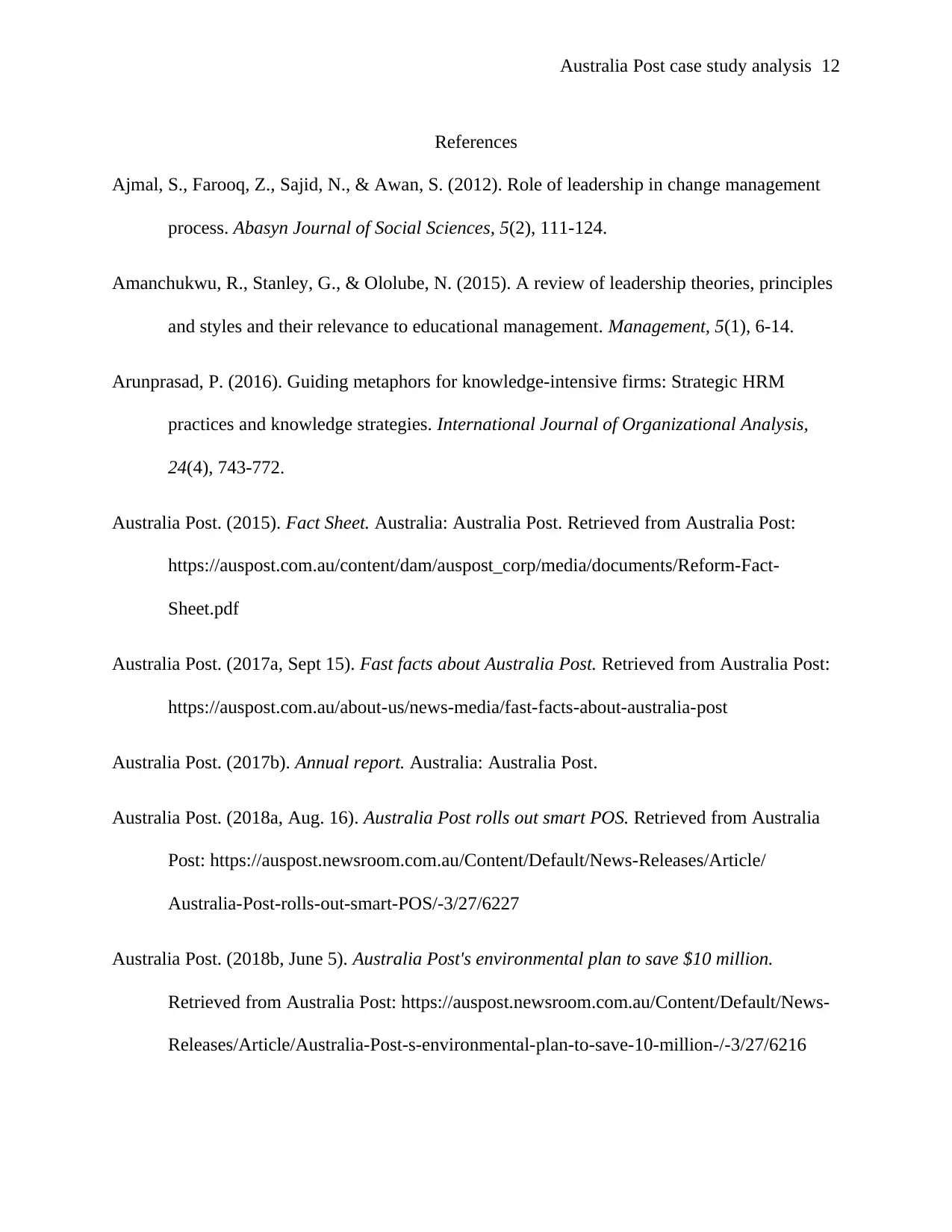
12Australia Post case study analysis
References
Ajmal, S., Farooq, Z., Sajid, N., & Awan, S. (2012). Role of leadership in change management
process. Abasyn Journal of Social Sciences, 5(2), 111-124.
Amanchukwu, R., Stanley, G., & Ololube, N. (2015). A review of leadership theories, principles
and styles and their relevance to educational management. Management, 5(1), 6-14.
Arunprasad, P. (2016). Guiding metaphors for knowledge-intensive firms: Strategic HRM
practices and knowledge strategies. International Journal of Organizational Analysis,
24(4), 743-772.
Australia Post. (2015). Fact Sheet. Australia: Australia Post. Retrieved from Australia Post:
https://auspost.com.au/content/dam/auspost_corp/media/documents/Reform-Fact-
Sheet.pdf
Australia Post. (2017a, Sept 15). Fast facts about Australia Post. Retrieved from Australia Post:
https://auspost.com.au/about-us/news-media/fast-facts-about-australia-post
Australia Post. (2017b). Annual report. Australia: Australia Post.
Australia Post. (2018a, Aug. 16). Australia Post rolls out smart POS. Retrieved from Australia
Post: https://auspost.newsroom.com.au/Content/Default/News-Releases/Article/
Australia-Post-rolls-out-smart-POS/-3/27/6227
Australia Post. (2018b, June 5). Australia Post's environmental plan to save $10 million.
Retrieved from Australia Post: https://auspost.newsroom.com.au/Content/Default/News-
Releases/Article/Australia-Post-s-environmental-plan-to-save-10-million-/-3/27/6216
References
Ajmal, S., Farooq, Z., Sajid, N., & Awan, S. (2012). Role of leadership in change management
process. Abasyn Journal of Social Sciences, 5(2), 111-124.
Amanchukwu, R., Stanley, G., & Ololube, N. (2015). A review of leadership theories, principles
and styles and their relevance to educational management. Management, 5(1), 6-14.
Arunprasad, P. (2016). Guiding metaphors for knowledge-intensive firms: Strategic HRM
practices and knowledge strategies. International Journal of Organizational Analysis,
24(4), 743-772.
Australia Post. (2015). Fact Sheet. Australia: Australia Post. Retrieved from Australia Post:
https://auspost.com.au/content/dam/auspost_corp/media/documents/Reform-Fact-
Sheet.pdf
Australia Post. (2017a, Sept 15). Fast facts about Australia Post. Retrieved from Australia Post:
https://auspost.com.au/about-us/news-media/fast-facts-about-australia-post
Australia Post. (2017b). Annual report. Australia: Australia Post.
Australia Post. (2018a, Aug. 16). Australia Post rolls out smart POS. Retrieved from Australia
Post: https://auspost.newsroom.com.au/Content/Default/News-Releases/Article/
Australia-Post-rolls-out-smart-POS/-3/27/6227
Australia Post. (2018b, June 5). Australia Post's environmental plan to save $10 million.
Retrieved from Australia Post: https://auspost.newsroom.com.au/Content/Default/News-
Releases/Article/Australia-Post-s-environmental-plan-to-save-10-million-/-3/27/6216
⊘ This is a preview!⊘
Do you want full access?
Subscribe today to unlock all pages.

Trusted by 1+ million students worldwide
1 out of 14
Related Documents
Your All-in-One AI-Powered Toolkit for Academic Success.
+13062052269
info@desklib.com
Available 24*7 on WhatsApp / Email
![[object Object]](/_next/static/media/star-bottom.7253800d.svg)
Unlock your academic potential
Copyright © 2020–2025 A2Z Services. All Rights Reserved. Developed and managed by ZUCOL.



